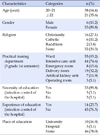Abstract
Purpose
To study the internal psychological conflicts among nursing students during an infection control protocol carried out in the hospital by measuring their observation skills and performance during clinical training.
Methods
Investigation of both pre- and post- infection control was conducted using questionnaires for clinical infection practices. We identified and evaluated the students' observation skills, clinical performance, clinical perception, and internal conflict regarding clinical infection control. We also interviewed the students as part of our study.
Results
Among parameters such as clinical performance, observation skills, clinical perception, and internal conflict, the average observation skills (t=5.49, p<.001) were significantly lower, while internal conflict among students (t=−7.23, p<.001) was significantly higher than expected prior to clinical training. Generally, there was a negative correlation between observation skills and internal conflict in every aspect of infection control practice (r=−.281, p=.031). Internal conflict was significantly higher than expected in the context of hand hygiene (t=−2.135, p=.037), personal hygiene (t=−3.48, p=.002), and ventilator management (t=−3.69, p<.001). Clinical performance of students in the context of hand hygiene (t=4.69, p<.001), personal hygiene (t=2.06, p=.044), and ventilator management (t=2.68, p<.001) was significantly lower than expected prior to clinical training.
Conclusion
Our findings showed that internal psychological conflict is higher when infection control practices are observed or performed to a lesser degree. Therefore, reinforcing education regarding infection control among students, such as developing a systematic program, or consecutive training and monitoring, is suggested.
Figures and Tables
References
1. Kim Y. Healthcare policy and healthcare utilization behavior to improve hospital infection control after the middle east respiratory syndrome outbreak. J Korean Med Assoc. 2015; 58(7):598–605. DOI: 10.5124/jkma.2015.58.7.598.

2. Kim EA, Choi BS, Kang SK. Evaluation of infectious disease in health care workers, focusing on management control of occupational safety and health system. Incheon: Korea Occupational Health and Safety Agency;2005.
3. Park YR. Knowledge, attitude and self-confidence of student nurses regarding nosocomial infection control. J Korean Acad Fundam Nurs. 2007; 14(4):429–436.
4. Kim GL, Choi ES. Recognition and performance on management for nosocomial infections among nursing students. Korean J Women Health Nurs. 2005; 11(3):232–240.

5. Choi MA, Park K. A study on the level of recognition and performance of the clinical nurses about the management of nosocomial infection. Unpublished master's thesis. Seoul: Chung-Ang University;2002.
6. Yang KH. Awareness and performance of the nurses to standard precautions for infection control in a university hospital [dissertation]. Chonbuk: Chonbuk National University;2010.
7. Park HM. A study on the level of recognition and performance of the clinical nurses about the management of nosocomial infect [dissertation]. Chunnam: Chunnam National University;2004.
8. Suh Y, Oh H. Knowledge, perception, safety climate, and compliance with hospital infection standard precautions among hospital nurses. J Korean Clin Nurs Res. 2010; 16(1):61–70.
9. Park BS, Cho H, Park BJ. Relationship of critical thinking disposition, self-esteem and job-seeking stress of nursing students. J Korea Acad Ind Coop Soc. 2015; 16(2):1109–1117. DOI: 10.5762/KAIS.2015.16.2.1109.

10. Jeong SY. Latest isolation guidelines among standard guideline. In : Korean Hospital Infection Control Association. 13th Conference; 2008. p. 3–8.
11. Siegel JD, Rhinehart E, Jackson M, Chiarello L. Committee HCICPA. 2007 guideline for isolation precautions: preventing transmission of infectious agents in health care settings. Am J Infect Control. 2007; 35(10):S65–S164.

12. Hong SY, Kwon YS, Park HO. Nursing students' awareness and performance on standard precautions of infection control in the hospital. J Korean Acad Soc Nurs Educ. 2012; 18(2):293–302. DOI: 10.5977/jkasne.2012.18.2.293.

13. Kang MY. A study on the performance of the management of nosocomial infection of the hospital nurses [dissertation]. Gongju: KongJu National University;2010.
14. Chong CU. Compliance level of universal precautions to hospital infection and related factors of health care workers in hospitals [dissertation]. Seoul: Yonsei University;2005.
15. Lee HG. Nosocomial infection control and related factors among emergency room nurses [dissertation]. Daegu: Kyungpook National University;2006.
16. Park HM, Hong MS. A study on the level of recognition and performance of the clinical nurses about the management of nosocomial infection [dissertation]. Gwangju: Chonnam National University;2004.
17. ko.wikipedia.org [Internet]. Wikipedia;2017 Apr 12. Available from: https://ko.wikipedia.org/wiki/.
18. Jeong SY, Kim O. The structural model of hand hygiene behavior for the prevention of healthcare-associated infection in hospital nurses. Korean J Adult Nurs. 2012; 24(2):119–129. DOI: 10.7475/kjan.2012.24.2.119.

19. Lee MH, Kang HS. A comparative study on profession-specific handwashing practices of ICU health care providers. J Korean Acad Fundam Nurs. 2007; 14(3):297–305.
20. Jeong MH. Survey of exposure to blood and body fluids, knowledge, awareness and performance on standard precautions of infection control in nursing students. J Korea Contents Assoc. 2015; 15(4):316–329. DOI: 10.5392/JKCA.2015.15.04.316.





 PDF
PDF ePub
ePub Citation
Citation Print
Print





 XML Download
XML Download